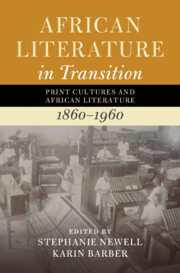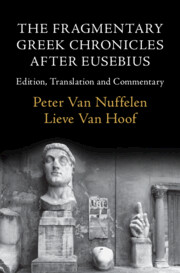Refine search
Actions for selected content:
631 results
28 - Religion and Poetry in Australia
-
-
- Book:
- The Cambridge History of Australian Poetry
- Published online:
- 19 November 2025
- Print publication:
- 11 December 2025, pp 523-537
-
- Chapter
- Export citation
The Semiotics of Aura: Copying Religious Images in Coptic Households
-
- Journal:
- Signs and Society ,
- Published online by Cambridge University Press:
- 13 November 2025, pp. 1-19
-
- Article
-
- You have access
- Open access
- HTML
- Export citation
4 - Evidence on Church Democratic Activism in Africa
- from Part II - Testing the Main Hypotheses
-
- Book:
- Faith in Democracy
- Published online:
- 23 October 2025
- Print publication:
- 06 November 2025, pp 73-99
-
- Chapter
- Export citation
2 - Liberal Democracy as an Institutional Guarantee of Church Interests
- from Part I - Theory
-
- Book:
- Faith in Democracy
- Published online:
- 23 October 2025
- Print publication:
- 06 November 2025, pp 29-45
-
- Chapter
- Export citation
3 - The Politics of Church Education in Sub-Saharan Africa
- from Part I - Theory
-
- Book:
- Faith in Democracy
- Published online:
- 23 October 2025
- Print publication:
- 06 November 2025, pp 46-70
-
- Chapter
- Export citation
9 - Reconsidering Churches, Education, and Democracy in the Contemporary World
- from Part IV - Extensions and Implications
-
- Book:
- Faith in Democracy
- Published online:
- 23 October 2025
- Print publication:
- 06 November 2025, pp 233-244
-
- Chapter
- Export citation
1 - Church Interests in Liberal Democracy
- from Part I - Theory
-
- Book:
- Faith in Democracy
- Published online:
- 23 October 2025
- Print publication:
- 06 November 2025, pp 3-28
-
- Chapter
-
- You have access
- HTML
- Export citation
7 - Latin in the Early History of English
- from Part II - Contact and External Influences
-
-
- Book:
- The New Cambridge History of the English Language
- Published online:
- 30 October 2025
- Print publication:
- 30 October 2025, pp 193-218
-
- Chapter
- Export citation
Chapter 4 - The Imperial Cosmopolis
-
- Book:
- The Roman Empire and World History
- Published online:
- 31 October 2025
- Print publication:
- 30 October 2025, pp 86-118
-
- Chapter
- Export citation

African Literature in Transition
- Print Cultures and African Literature, 1860–1960
-
- Published online:
- 23 October 2025
- Print publication:
- 06 November 2025

Faith in Democracy
- The Logic of Church Advocacy for Liberal Democratic Institutions in Africa
-
- Published online:
- 23 October 2025
- Print publication:
- 06 November 2025
2 - Maritime Practice and Virtual Geography
-
- Book:
- The Kuroshio Frontier
- Published online:
- 11 October 2025
- Print publication:
- 23 October 2025, pp 52-75
-
- Chapter
-
- You have access
- Open access
- HTML
- Export citation
2 - Against the Galileans I
-
- Book:
- The Narrative Conflict of Traditions in the Late Antique World
- Published online:
- 22 September 2025
- Print publication:
- 09 October 2025, pp 73-98
-
- Chapter
- Export citation
3 - Against the Galileans II
-
- Book:
- The Narrative Conflict of Traditions in the Late Antique World
- Published online:
- 22 September 2025
- Print publication:
- 09 October 2025, pp 99-118
-
- Chapter
- Export citation
2 - Epistemologies of the Secret Elsewhere
-
- Book:
- The Epistemology of the Secret
- Published online:
- 23 July 2025
- Print publication:
- 09 October 2025, pp 40-64
-
- Chapter
- Export citation
Chapter 30 - Jerusalem
- from Africa and the Middle East
-
-
- Book:
- The Cambridge Guide to Global Medieval Travel Writing
- Published online:
- 03 October 2025
- Print publication:
- 02 October 2025, pp 537-552
-
- Chapter
- Export citation
“Let Perpetual Light Shine upon Them”: Forgetting and Remembering Segregated Catholic Cemeteries
-
- Journal:
- American Antiquity , First View
- Published online by Cambridge University Press:
- 01 October 2025, pp. 1-24
-
- Article
-
- You have access
- Open access
- HTML
- Export citation
Chapter 13 - Devotional Poetry
- from Part II - Forms and Genres
-
-
- Book:
- Michael Field in Context
- Published online:
- 03 October 2025
- Print publication:
- 25 September 2025, pp 114-122
-
- Chapter
- Export citation

The Fragmentary Greek Chronicles after Eusebius
- Edition, Translation and Commentary
-
- Published online:
- 11 September 2025
- Print publication:
- 24 July 2025
Chapter 11 - Religion
- from Part II - Themes and Issues
-
-
- Book:
- The Cambridge Companion to Modernist Theatre
- Published online:
- 28 August 2025
- Print publication:
- 11 September 2025, pp 198-216
-
- Chapter
- Export citation
